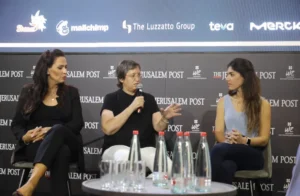Executives from throughout the hi-tech industry gathered during the first inaugural Women’s Entrepreneurship Summit to share their knowledge and experience with female entrepreneurs.

“Let’s start by establishing that hi-tech is really the best place for women,” began Dorit Dor, Chief Product Officer for Checkpoint, during a panel at Tuesday night’s first inaugural Women’s Entrepreneurship Summit from The Jerusalem Post and WE (Women’s Entrepreneurship). During the event, executives from throughout the hi-tech industry gathered to share their knowledge and experience with female entrepreneurs across the country.
Dor elaborated on the juxtaposition between the many good opportunities for women in hi-tech and the relative lack of their presence in the sector. “As well as learning technology, it’s the best opportunity for getting paid. It’s the best opportunity for life balance because you could work from home in all the hi-tech industry, it’s the best for every reason you could think of to work in high tech – and still very few select this,” she said.
“We have an issue,” she continued and explained why she believes the current branding of hi-tech is repulsive for diverse groups of workers. “For example, in cyber, you wear a hoodie and drink a lot of coke, or the men doing it in high school are not socially acceptable,” she said. These impressions make women fearful that they wouldn’t be socially accepted if they were in the industry, Dor suggested.
Besides problematic branding, the hi-tech industry offers several other hurdles for women, explained Dor, including the requirement to “opt in” in order to achieve success and the need to loudly self-advocate for themselves. “Usually women don’t do this very well,” she said.
In an effort to correct these issues, Checkpoint runs initiatives helping young kids choose high tech and mentoring women to speak up for themselves and pursue promotion. “In the end, if you had a whole list of [mid-level employees] that are women, maybe that would help as well.”
Investment in women isn’t doing well
Yifat Oron is the Senior Managing Director at Blackstone, a hi-tech investment firm with $941 billion in Assets Under Management. She elaborated on the current shortage of investment in female entrepreneurs, which isn’t doing gangbusters, to say the least.
“$330 billion invested in tech by VCs last year – what’s the percentage invested in women entrepreneurs? Two percent,” Oron remarked. “A little less bad is the amount of money invested in companies that have women in the founding team: 16%. It’s still very bad.”
By means of explanation, Oron indicated that the lack of investment in women stems from a lack of female investors. “The statistics are not glamorous at all. It’s [something like] 15% of General Partners (GPs) are women,” she said, while acknowledging that even as little as 10 years ago, these numbers wouldn’t be as “high” – in this sense some progress has been made. Regardless, she pointed out, “If we’re not going to have GPs that are women, we’re not going to have entrepreneurs that are women.”
In order to help female entrepreneurship along, Oron explained that “Blackstone – as did most older investment firms – had to do some work to elevate the number of women investors, because this is a very much a men-led business.”
As such, Blackstone has made an effort to train and hire women, launch mentorship programs and invest in hi-tech awareness in high schools. These efforts have been fairly effective: “Half of our incoming class this year of new employees are women; hopefully most of them are going to stay throughout their careers with us,” Oron said. As well, last year Blackstone invested $10 billion in women-led companies.
These successes are not just happenstance, however. “It’s not happening just because it’s happening,” noted Oron. “We’re doing a lot of work, and everybody here who is employing people needs to take charge and make sure they spend a lot of energy on that as well.”
She concluded with a note regarding the importance of female representation in the business hierarchy. “If you want to be able to do the right thing, you have to have a well-balanced leadership. Not necessarily just CEOs; you have to have a lot of women represented well across every single layer of the organization,” she said. “Research has shown that heterogeneous leadership and boards perform better than homogeneous ones. It’s pretty simple.”
How to succeed in business (without a Y chromosome)
During the panel, Inbar Badian, Head of Strategy and Innovation for the Microsoft Research and Development Center, explained how she managed to achieve her career success despite her relatively young age.
She began her time at Microsoft in a two-year rotational program, which required her to move between three different engineering groups in order to become a product manager. “Each of these domains required different tools, different capabilities, different people. So I had to learn quickly, in order to close the gap of experience that I had.”
In order to effectively learn the ropes, she divided her mental training into two categories. “The first one was focused on the product. I had to quickly understand the market and competitors to the smallest details and to learn the technical aspects of the product and everything related to the people working with me: whether the engineering teams, the designers, and so on,” she said.
“The second [category] is related to the people that I had to work with,” she said. “Eventually everything is about the people. And as a product manager, you need to make sure that everyone’s engaged, and that you’re talking correctly with all the different people that you’re working with.”
To that point, collaborating with experienced coworkers and allowing them to mentor her was a key element to her success. “I gathered people from all over Microsoft – women and men, it’s important to mention – that helped me first of all with technical tax tasks, and eventually with more strategic tasks. These mentorships that I got helped me grow both personally and professionally.”
